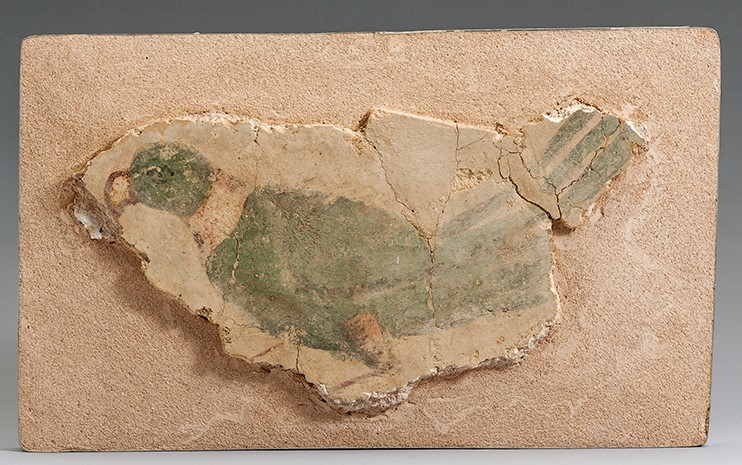Acquisition number: 1978.04
The fragment has a standing bird, left. Much of the paint is faded and the surface somewhat worn. The background is cream. The bird's feathers are mid-green with black for the eye and other details. Its collar is red (mostly worn away); red is used too for the outline of the beak, possibly with yellow. The legs are yellow-brown with red for the lower part.
Title: Fragment of Roman Wall-Painting - 1978.04
Acquisition number: 1978.04
Author or editor: J.R. Green
Culture or period: Roman Imperial
Date: Mid 1st century AD.
Material: Plaster
Object type: Wall-painting
Dimensions: 330mm (l)
Origin region or location: Italy
Display case or on loan: 12
Keywords: Roman, Imperial, Fragment
Sotheby Parke Bernet (New York), Sale Cat., 10 April 1978, no. 183 (ill.); J.R. Green with B. Rawson, Catalogue of Antiquities in the Australian National University, A.N.U. (Canberra, 1981) 108.
1978.04
Fragment of Roman Wall-Painting
Purchased. Max. length ca 33cm.
The fragment has a standing bird, left. Much of the paint is faded and the surface somewhat worn. The background is cream. The bird's feathers are mid-green with black for the eye and other details. Its collar is red (mostly worn away); red is used too for the outline of the beak, possibly with yellow. The legs are yellow-brown with red for the lower part.
To judge by other representations as well as the angle of the tail, the bird was probably perched on some object, most likely a dish or basin. The bird is presumably some type of parrot; the same type is represented on a mosaic in the Naples Museum.
Perhaps mid-first century AD.
Sotheby Parke Bernet (New York), Sale Cat., 10 April 1978, no. 183 (ill.); J.R. Green with B. Rawson, Catalogue of Antiquities in the Australian National University, A.N.U. (Canberra, 1981) 108.
